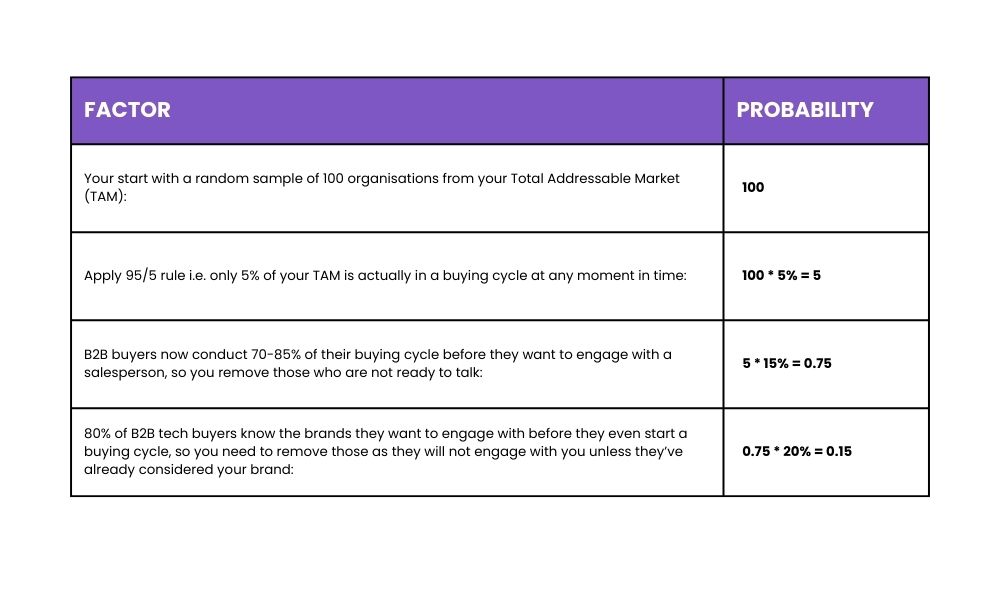
If I asked you to invest in something where your probability of even getting your money back was less than 1%, you would dismiss me as crazy and walk away. However, most B2B marketers are operating in a world where their odds of success can be as low as 0.15%.
Understanding the odds of generating a lead
Over the past decade the B2B buyer and buying process has been changing, and in many instances this change has been dramatic. At the same time, the pressure placed on marketing teams to generate directly attributable ROI has increased significantly. The result is a disconnect and it is this gap that is stacking the odds against B2B marketers.
Let me explain. The following clearly demonstrates the scale of the lead generation challenge.

The harsh reality of this simplified analysis is that for every 100 organisations you reach out to, you have just a 0.15% probability of landing on a sales-ready lead.
The disconnect between Buyer and Marketing
Every day I see marketing teams in tech companies under considerable pressure to generate sales-ready leads. The Head of Sales will never have enough leads, and as sales cycles lengthen and competition intensifies, the logical answer is to demand that marketing generate more opportunities.
For CEOs and CFOs, the drive for profitability means that marketing is under more scrutiny to justify ROI. Digital marketing has blessed us with the ability to measure results, however, it has driven marketers to focus on direct attribution lead generation that is not aligned to how buyers behave today.
The result is a disconnect between the buyer and marketing activity. Many marketing teams are focused on bottom of the funnel activities to drive the ‘contact us’ or ‘get a demo’ hand raiser but this is the opposite of what the buyer wants to do; they want to serve themselves until they are ready are ready to buy, not be forced along their journey at a faster rate than is comfortable for them.
Realigning B2B marketing with the buyer
The only way to address the gap and to turn the odds back in your favour is to align your marketing strategy and activity to the way today’s buyers buy.
(i) Brand
To be one of the companies that the buyer knows and wants to consider as they enter their buying cycle you need to have already captured their attention and be remembered as relevant. This requires focusing on building a distinctive brand. This is activity that does not generate a directly attributable ROI as the hard work is required before a buyer is ready to engage with you, however it only increases your probability from 0.15% to 0.75%.
(ii) Self-Serve Engagement & Trust
Whether it is 70% or 85% of the buying cycle being conducted before engagement with a salesperson, the reality is that you need to be able to influence the buyer during this self-serve phase. If you are providing them with the information they need, adding value to their thought process, you are stacking the odds in your favour. This requires content that is aligned with what the buyer wants and for this to be readily accessible (not hidden behind gates). It’s quite simple, the more the buyer engages with your content, the less they are engaging with the competition. Get this right and you turn the 0.75% probability back to the 5% probability.
(iii) Be there at the right time
The worst thing that you can do is pester someone to do something they don’t want to do. This is why it is all about timing. Marketers, me included, love lead scoring, measuring activity to generate Marketing Qualified Leads (MQLs). The reality is we need to start thinking about realigning this model to the buying cycle. With the level of self-serve buying, it is easy for an individual to quickly accumulate enough points to be classed as an MQL when in reality they may be weeks, months or even years away from being ready to engage.
Integrated marketing & correlation is key
Organisations need to break the vicious cycle of focusing marketing on direct attribution lead generation; the odds are against you and all you are doing is widening the gap between you and the buyer.
Marketing needs to be viewed as part of the sales process and this starts from the very first time you capture a ‘future’ buyer’s attention. Integrated marketing is key – building brand value with the potential buyer, providing them with content to self-serve during their early buying cycle and winning the trust that is so critical in ensuring they reach out to you when they are ready.
So how do we measure marketing success? It is not about the number of conversions from your Google PPC campaign, it is about the revenue growth from your marketing investment. To truly understand the effectiveness of integrating your marketing, stop looking to quantify each channel, but focus on the correlation between programs. i.e. how does organic social drive visitors to my website, how does content drive deeper engagement, and how does these and other components effect enquires and sales pipeline overtime.
It’s time to be brave and reconnect your marketing with the buyer.
Wondering how to restack the odds in your favour? Listen to our B2B Tech Marketing podcast!
In this episode, Gary speaks with Gabe about how the odds are stacked against the B2B Tech marketers of today, and what can be done to combat this through shifts in mindset to realign marketing with the buyer, and starting with a foundational layer of core activity spanning self-serve content and integrated digital marketing.